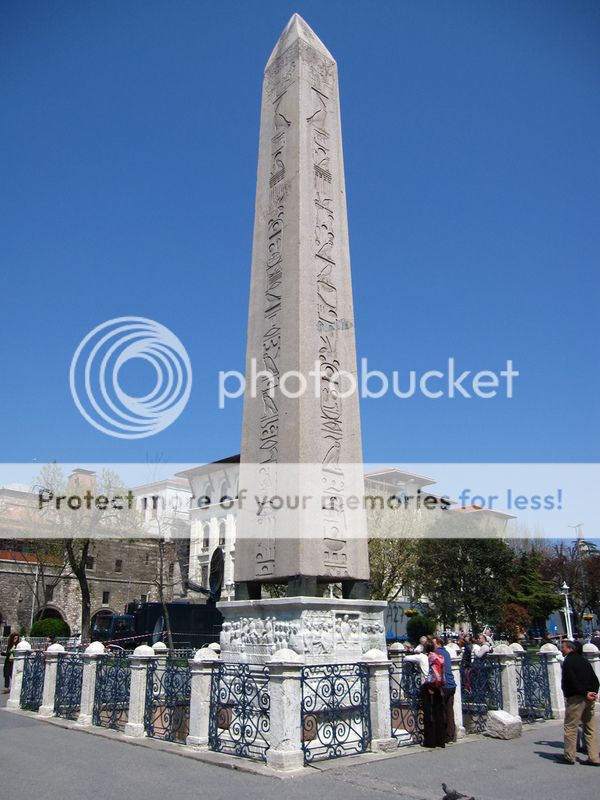GPS : 41°00'21.3"N 28°58'31.4"E / 41.005921, 28.975382

PHOTOGRAPHS ALBUM
The Obelisk of Theodosius (Turkish: Dikilitaş) is the Ancient Egyptian obelisk of Pharaoh Tutmoses III re-erected in the Hippodrome of Constantinople (known today as At Meydanı or Sultanahmet Meydanı, in the modern city of Istanbul, Turkey) by the Roman emperor Theodosius I in the 4th century AD.
The obelisk was first set up by Tutmoses III (1479-1425 BC) to the south of the seventh pylon of the great temple of Karnak. The Roman emperor Constantius II (337-361 AD) had it and another obelisk transported along the river Nile to Alexandria to commemorate his ventennalia or 20 years on the throne in 357.
The Obelisk of Theodosius is the Ancient Egyptian obelisk of Pharaoh Tutmoses III which was re-erected in the Hippodrome of Constantinople by the Roman emperor Theodosius I who ruled 378-392 AD.
The other obelisk was erected on the spina of the Circus Maximus in Rome in the autumn of that year, and is today known as the Lateran obelisk, whilst the obelisk that would become the obelisk of Theodosius remained in Alexandria until 390, when Theodosius I (378-392 AD) had it transported to Constantinople and put up on the spina of the Hippodrome there.
The obelisk was first set up by Tutmoses III (1479-1425 BC) at the great temple of Karnak. Each of its four faces has a single central column of inscription, celebrating Tutmoses III's victory on the banks of the river Euphrates in 1450 BC.
The Obelisk of Theodosius is of red granite from Aswan and was originally 30 m tall, like the Lateran obelisk. The lower part was damaged in antiquity, probably during its transport or re-erection, and so the obelisk is today only 18.54 m (or 19.6 m) high, or 25.6 m if the base is included. Between the four corners of the obelisk and the pedestal are four bronze cubes, used in its transportation and re-erection.
The marble pedestal had bas-reliefs dating to the time of the obelisk's re-erection in Constantinople. On one face Theodosius I is shown offering the crown of victory to the winner in the chariot races, framed between arches and Corinthian columns, with happy spectators, musicians and dancers assisting in the ceremony. In the bottom right of this scene is the water organ of Ctesibius and on the left another instrument.
This obelisk once graced the Karnak Great Temple of Amun (Amon) in ancient Thebes (now, Luxor). It was one of two erected at the south of the 7th Pylon of the Great Temple by Tuthmosis III. No one knows who ordered its removal from Karnak, or whether it was still standing when it was taken. It was transported to Alexsandria under the orders of the Byzantine (Eastern Roman) Emperor Constantius II [reigned A.D. 337-361.
He is different from Constantinus II, just one letter is different ("tius" vs. "tinus"), who transported an obelisk to Rome, which is now called "Lateran Obelisk", and then finally transported to Constantinople now Istanbul] by the Byzantine Emperor Theodosius I [reigned A.D. 379-395]. It was erected in A.D. 390.
There are obvious traces of major damage to the pedestal and energetic restoration of it. Missing pieces have been replaced, at the pedestal's bottom corners, by cubes of porphyry resting on the bronze cubes already mentioned - the bronze and porphyry cubes are of identical form and dimensions. There is also a vertical gash up one of the obelisk's faces, which look like a canal from above. These repairs to the base may be linked to the cracking of the obelisk itself after its suffering a serious accident (perhaps an earthquake) at an unknown date in antiquity
The pedestal's east face bears an inscription in five Latin hexameters. This is slightly broken at the bottom but it was transcribed in full by travellers in the 16th century. It reads :
DIFFICILIS QVONDAM DOMINIS PARERE SERENIS
IVSSVS ET EXTINCTIS PALMAM PORTARE TYRANNIS
OMNIA THEODOSIO CEDVNT SVBOLIQVE PERENNI
TER DENIS SIC VICTVS EGO DOMITVSQVE DIEBVS
IVDICE SVB PROCLO SVPERAS ELATVS AD AVRAS
Translation : "Though formerly I opposed resistance, I was ordered to obey the serene masters and to carry their palm, once the tyrants had been overcome. All things yield to Theodosius and to his everlasting descendants. This is true of me too - I was mastered and overcome in three times ten days and raised towards the upper air, under governor Proculus."
On the west face the same idea is repeated in two elegiac couplets rendered in Byzantine Greek, though this time it reports that the re-erection took 32 days (TPIAKONTA ΔYO, last line) not 30
KIONA TETPAΠΛEYPON AEI XΘONI KEIMENON AXΘOC
MOYNOC ANACTHCAI ΘEYΔOCIOC BACIΛEYC
TOΛMHCAC ΠPOKΛOC EΠEKEKΛETO KAI TOCOC ECTH
KIΩN HEΛIOIC EN TPIAKONTA ΔYO
Translation : "This column with four sides which lay on the earth, only the emperor Theodosius dared to lift again its burden; Proclos was invited to execute his order; and this great column stood up in 32 days."
Only the top section survives, and it stands today where Theodosius placed it, on a marble pedestal. The obelisk has survived nearly 3,500 years in astonishingly good condition.
LOCATION SATELLITE MAP
These scripts and photographs are registered under © Copyright 2016, respected writers and photographers from the internet. All Rights Reserved.
No comments:
Post a Comment